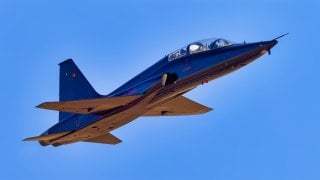I Never Got a Chance to Fly a T-38 Talon: The Air Force's Essential Fighter
Being medically discharged from a pilot slot in the U.S. Air Force left me with several disappointments. One was the lost opportunity to fly the Northrop T-38 Talon, a two-seat supersonic jet that has been used to train generations of Air Force fighter and bomber pilots.
Being medically discharged from a pilot slot in the U.S. Air Force left me with several disappointments. One was the lost opportunity to fly the Northrop T-38 Talon, a two-seat supersonic jet that has been used to train generations of Air Force fighter and bomber pilots.
All USAF pilots attend Undergraduate Pilot Training (UPT). Upon graduation, young officers earn their wings.
UPT is divided into three distinct phases. The first phase is purely academic and ground training, devoid of flying. In the second phase, students fly for the first time in the T-6 Texan, an old prop trainer. In the third phase, students are divided into one of three tracks, corresponding with the type of aircraft the pilot will eventually fly. These include the tanker/heavy track, which trains in the T-1A; the helicopter track, in the UH-1; and the fighter/bomber track in the T-38C.
Like you might expect from a 20-something athlete turned pilot, I was intent on securing a place in the T-38C track. Once they graduate, fighters from the T-38 track are typically slotted into a fighter, bomber, or attack aircraft. I wanted a fighter. Preferably something with two engines, so that I could tell worried friends and family –and myself – some story about redundancy and everything being relatively safe.
T-38 Talon: Decades of Service
My eagerness to fly the T-38, and my disappointment at never getting the chance, come from two primary sources: the jet’s performance and its lineage.
The T-38 features a conventional configuration with a small, low-mounted, long-chord wing, a single vertical stabilizer, and a tricycle undercarriage. The jet can take off on just 2,300 feet of runway, and it can climb to 30,000 feet in one minute. Remarkably, the jet can complete 720 degrees of roll in just one second. That’s two complete barrel rolls.
When the T-38 was introduced in the 1960s, the trainer was considered too easy to fly relative to the fighters pilot trainees would graduate into – aircraft like the Century Series that could be notoriously difficult to handle. Sixty years later, however, the T-38 is considered the hardest-too-handle aircraft in the entire Air Force inventory. Pilot trainees have come to revere the T-38 as aerodynamically unforgiving.
The T-38 made its first flight in 1959, when Dwight D. Eisenhower was still in office. In all, nearly 1,200 T-38s have been produced. Along the way, several high-profile accidents have occurred. In the 1960s, a string of T-38 accidents killed members of the NASA astronaut corps who used the aircraft for transportation and testing. Astronaut Theodore Freeman was killed in 1964 after a bird strike on his T-38. In 1966, astronauts Elliot See and Charles Bassett were killed after overrunning a runway while landing in the fog. And in 1967, astronaut Clifton Williams died in a T-38 crash after his aileron jammed.
Now the Air Force is phasing out the T-38. The T-7 Redhawk will be used to train upcoming generations of USAF pilots.
About the Author: Harrison Kass
Harrison Kass is a defense and national security writer with over 1,000 total pieces on issues involving global affairs. An attorney, pilot, guitarist, and minor pro hockey player, Harrison joined the US Air Force as a Pilot Trainee but was medically discharged. Harrison holds a BA from Lake Forest College, a JD from the University of Oregon, and an MA from New York University. Harrison listens to Dokken.
Image Credit: Shutterstock.


